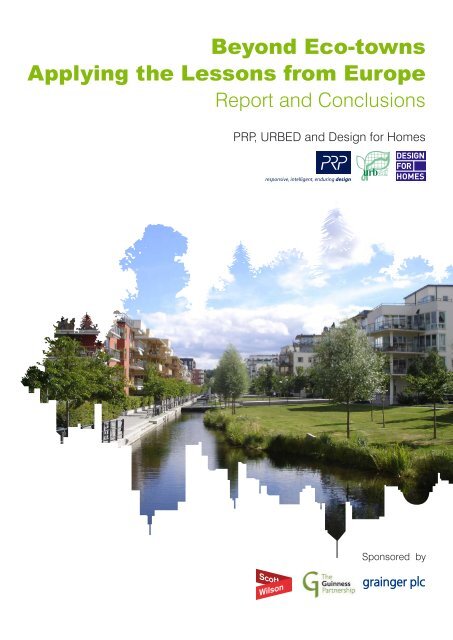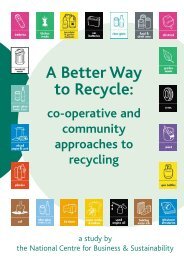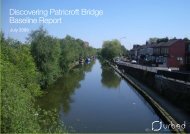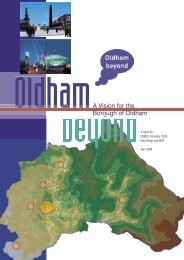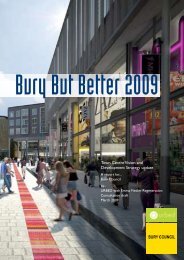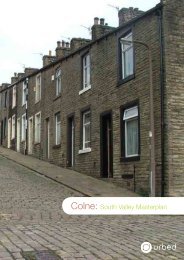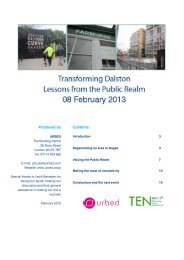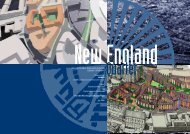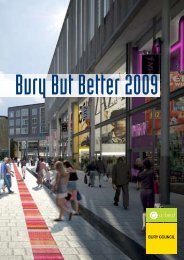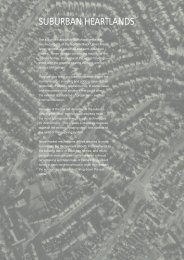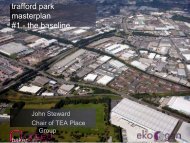Beyond Eco-towns Applying the Lessons from Europe - Urbed
Beyond Eco-towns Applying the Lessons from Europe - Urbed
Beyond Eco-towns Applying the Lessons from Europe - Urbed
You also want an ePaper? Increase the reach of your titles
YUMPU automatically turns print PDFs into web optimized ePapers that Google loves.
<strong>Beyond</strong> <strong>Eco</strong>-<strong>towns</strong><br />
<strong>Applying</strong> <strong>the</strong> <strong>Lessons</strong> <strong>from</strong> <strong>Europe</strong><br />
Report and Conclusions<br />
PRP, URBED and Design for Homes<br />
Sponsored by
<strong>Beyond</strong> <strong>Eco</strong>-<strong>towns</strong><br />
<strong>Applying</strong> <strong>the</strong> <strong>Lessons</strong> <strong>from</strong> <strong>Europe</strong><br />
Report and Conclusions<br />
Written and researched by PRP Architects Ltd,<br />
URBED and Design for Homes<br />
Published October 2008 by<br />
PRP Architects Ltd<br />
10 Lindsey Street<br />
Smithfield<br />
London<br />
EC1A 9HP<br />
Tel: +44 (0)20 7653 1200<br />
Fax: +44 (0)20 7653 1201<br />
Copyright © PRP Architects Ltd<br />
All rights reserved. No part of this publication<br />
may be reproduced, stored in a retrieval<br />
system or transmitted in any form or by any<br />
means electronic, mechanical, photocopying<br />
recording or o<strong>the</strong>rwise without <strong>the</strong> prior<br />
permission of <strong>the</strong> publishers.<br />
Copies available <strong>from</strong> PRP Architects Ltd.<br />
ISBN: 978-0-9560622-0-8<br />
Printed on FSC certified paper<br />
(paper produced only <strong>from</strong> woodpulp originating<br />
<strong>from</strong> managed sustainable plantations)
<strong>Beyond</strong> <strong>Eco</strong>-<strong>towns</strong><br />
<strong>Applying</strong> <strong>the</strong> <strong>Lessons</strong> <strong>from</strong> <strong>Europe</strong><br />
Report and Conclusions
Contacts<br />
Andy von Bradsky<br />
Chairman<br />
PRP<br />
10 Lindsey Street<br />
Smithfield<br />
London<br />
EC1A 9HP<br />
Tel: +44 (0)20 7653 1200<br />
Fax: +44 (0)20 7653 1201<br />
E: andy.vonbradsky@prparchitects.co.uk<br />
www.prparchitects.co.uk<br />
Dr Nicholas Falk<br />
Founder Director<br />
URBED (Urban and <strong>Eco</strong>nomic Development) Ltd<br />
26 Gray’s Inn Road<br />
London<br />
WC1X 8HP<br />
Tel: +44 (0)20 7831 9986<br />
Fax: +44 (0)20 7831 2466<br />
E: n.falk@urbed.co.uk<br />
www.urbed.co.uk<br />
David Birkbeck<br />
Chief Executive<br />
Design for Homes<br />
The Building Centre<br />
26 Store Street<br />
London<br />
WC1E 7BT<br />
Tel: +44 (0)870 4163 378<br />
Fax: +44 (0)20 7436 0573<br />
E: david@designforhomes.org<br />
www.designforhomes.org
Acknowledgements<br />
The authors would like to thank our sponsors; Scott Wilson, The Guinness Partnership and Grainger plc. Who have not only<br />
provided financial assistance but also have contributed to <strong>the</strong> production of this report, we would also like to thank all those who<br />
attended <strong>the</strong> various study tours listed below and our sponsors.<br />
1-3 April 2008 Study Tour to Kronsberg, Hanover, Germany<br />
and HafenCity, Hamburg, Germany attended by;<br />
Dr Ka<strong>the</strong>rine Hyde<br />
John Oldham<br />
Nick Parkinson<br />
Jim Bennett<br />
Duncan Jenkins<br />
Deirdra Armsby<br />
Tony Bates<br />
John Keily<br />
James Robinson<br />
BRE<br />
Countryside Properties<br />
Hill Residential Ltd<br />
Housing Corporation<br />
Lands Improvement<br />
London Borough of Newham<br />
Scott Wilson<br />
The Guinness Partnership<br />
The Guinness Partnership<br />
Thanks to Karin Rumming, Department of <strong>the</strong> Environment,<br />
city of Hanover<br />
10-11 July 2008 Study Tour to Hammarby Sjöstad, Stockholm,<br />
Sweden and <strong>Eco</strong>-town Conference attended by;<br />
Paula Hurst<br />
Judith Stead<br />
Martin Tett<br />
Ian Millard<br />
Clive Wilding<br />
Alastair Baird<br />
Graham Brown<br />
Joakim Karlsson<br />
Jonas Tornblom<br />
Paul Storey<br />
Deborah Webb<br />
Paul Rogatzki<br />
Andrew Howard<br />
David My<strong>the</strong>n<br />
Kent Thornycroft<br />
Peter Frackiewicz<br />
John Hunter<br />
Roberto Bruni<br />
Simon Rees<br />
Richard Lavington<br />
Gerard Maccreanor<br />
John Lewis<br />
Austin Baggett<br />
Neil Jefferson<br />
Elizabeth Morello-Gower<br />
Paul Pearce<br />
Academy for Sustainable Communities<br />
Academy for Sustainable Communities<br />
Aylesbury Vale Advantage<br />
Barking Riverside<br />
Barking Riverside<br />
Barratt Homes (East)<br />
Denne Construction<br />
ENVAC<br />
ENVAC<br />
Grainger plc<br />
Grainger plc<br />
Hanson<br />
HardHat Communications<br />
Hyder Consulting<br />
Hyder Consulting<br />
Land Securities<br />
London Borough of Dagenham & Barking<br />
London Borough of Newham<br />
London Borough of Newham<br />
Maccreanor Lavington<br />
Maccreanor Lavington<br />
Milton Keynes Partnership<br />
National Energy Services<br />
NHBC<br />
Notting Hill Housing Trust<br />
Notting Hill Housing Trust<br />
Stephen Compton<br />
Philip Harker<br />
Sarah Deepwell<br />
Joanne Fallon<br />
Hayley Sheard<br />
Rob Hannabuss<br />
Neal Hunt<br />
Chris Johnson<br />
Suzanne Wolfe<br />
Richard Parker<br />
Simon Tanner<br />
Andrew Partridge<br />
Paul Thompson<br />
Yolande Barnes<br />
Tony Bates<br />
Andrew Clifford<br />
Oona Moorhead<br />
Daniel Burr<br />
Victoria Perkins<br />
Charles Scott<br />
Henrik Svanqvist<br />
Youssef Kadiri<br />
John Slater<br />
Stephen Cains<br />
Benjamin Staite<br />
Jim Johnsone<br />
Stellan Fryxell<br />
John Kiely<br />
Julian Knapp<br />
James Robinson<br />
John Alker<br />
Opportunity Peterborough<br />
Opportunity Peterborough<br />
Plus Housing Group<br />
Plus Housing Group<br />
Plus Housing Group<br />
Poplar HARCA<br />
Poplar HARCA<br />
Poplar HARCA<br />
Poplar HARCA<br />
Pricewaterhouse Coopers<br />
Pricewaterhouse Coopers<br />
Rogers Stirk Harbour<br />
Rogers Stirk Harbour<br />
Savills<br />
Scott Wilson<br />
Scott Wilson<br />
SEEDA<br />
Sheppard Robson<br />
Sheppard Robson<br />
Sheppard Robson<br />
Skanska<br />
Skanska<br />
Stuart Milne Group<br />
Swindon Borough Council<br />
Swindon Borough Council<br />
Tees Valley Living<br />
Tengbom Architects<br />
The Guinness Partnership<br />
The Guinness Partnership<br />
The Guinness Partnership<br />
UK Green Building Council<br />
27-28 August 2008 Study Tour to Kattenbroek, Nieuwland and<br />
Vathorst,Amersfoort, The Ne<strong>the</strong>rlands<br />
Anna Keyes<br />
David Carrigan<br />
Sarah Beck<br />
Alan Gorman<br />
Kathryn Macgray<br />
Tony Bates<br />
Karl Walker<br />
James Robinson<br />
John Kiely<br />
Cambridgeshire Horizons<br />
Housing Corporation<br />
Medway Council<br />
PricewaterhouseCoopers<br />
PricewaterhouseCoopers<br />
Scott Wilson<br />
Scott Wilson<br />
The Guinness Partnership<br />
The Guinness Partnership
Hammarby Sjöstad - even at higher densities <strong>the</strong> treatment of<br />
open space and urban landscape can provide a good quality of life<br />
for families<br />
4
Contents<br />
1.0 Summary<br />
2.0 Introduction<br />
3.0 The Places<br />
4.0 Why <strong>Europe</strong>?<br />
5.0 Our Methodology<br />
6.0 Messages <strong>from</strong> <strong>Europe</strong>an Experience<br />
7.0 Conclusions and Key Recommendations<br />
8.0 References<br />
9.0 Credits<br />
6<br />
10<br />
11<br />
13<br />
15<br />
16<br />
24<br />
28<br />
29<br />
5
1.0 Summary<br />
The UK Government’s concept of <strong>Eco</strong>-<strong>towns</strong> has aroused great interest, but has also generated<br />
considerable scepticism and opposition to particular proposals. <strong>Eco</strong>-<strong>towns</strong> should be exemplary places<br />
that help drive standards up. Hence it is essential that we do not repeat <strong>the</strong> mistakes of <strong>the</strong> past as<br />
happened with system built tower blocks, for example. Instead, we should be able to learn <strong>from</strong> places<br />
that have been building better and larger homes, at a much faster rate than <strong>the</strong> UK has yet achieved.<br />
PRP, URBED and Design for Homes have <strong>the</strong>refore joined forces to share our considerable experience<br />
of <strong>Europe</strong>an developments and to look more closely at <strong>the</strong> process that lay behind <strong>the</strong>m.<br />
This report summarises <strong>the</strong> aims of <strong>the</strong> <strong>Eco</strong>-Towns initiative, sets out <strong>the</strong> conclusions we have drawn <strong>from</strong><br />
similar developments in <strong>Europe</strong> which address <strong>the</strong> concerns about deliverability, economic viability, building<br />
new communities and creating a sense of place. From this we have been able to draw conclusions for<br />
<strong>the</strong> way ahead. The report builds upon our interim report produced in July 2008 which was presented at<br />
an event in Stockholm in mid July with a view to drawing out recommendations for applying <strong>the</strong> <strong>Eco</strong>-town<br />
principles successfully in <strong>the</strong> British context.<br />
Since July we have undertaken a study tour to Amersfoort in The Ne<strong>the</strong>rlands. This has provided<br />
fur<strong>the</strong>r information and provoked more detailed consideration of how <strong>the</strong> economics of development<br />
and infrastructure, as well as <strong>the</strong> management of <strong>the</strong> development process, needs to be reviewed and<br />
changed within <strong>the</strong> UK if we are to improve our performance to <strong>Europe</strong>an levels.<br />
We have subtly altered <strong>the</strong> title of our report to ‘<strong>Beyond</strong> <strong>Eco</strong>-<strong>towns</strong>’ because we feel that <strong>the</strong> implications<br />
of our findings need to be applied more widely and engrained in a wholly new approach to large scale<br />
sustainable development, much of which will inevitably take <strong>the</strong> form of regeneration or urban extensions<br />
ra<strong>the</strong>r than in stand-alone new communities. This is not to discount <strong>the</strong> valuable lessons that will come<br />
out of <strong>the</strong> ongoing <strong>Eco</strong>-town initiative.<br />
The structure of this report follows that of <strong>the</strong> interim report but provides additional illustrations and<br />
material plus an updated conclusions section. However, it is inevitably still a short summary of our work.<br />
Fur<strong>the</strong>r and more detailed information is available through contacting <strong>the</strong> lead persons in each of <strong>the</strong><br />
three organisations. In particular, we have produced <strong>the</strong> following documents which are available <strong>from</strong><br />
<strong>the</strong> PRP website - www.prparchitects.co.uk:<br />
• Case studies of each of <strong>the</strong> six exemplars<br />
• A more detailed case study of Amersfoort based on <strong>the</strong> August 2008 study visit<br />
• A matrix of comparative key information for each of <strong>the</strong> six places<br />
• A working paper entitled ‘<strong>Beyond</strong> <strong>Eco</strong>-<strong>towns</strong>: The economic issues’ by<br />
Dr Nicholas Falk (URBED).<br />
6
Kronsberg was built as a<br />
demonstration project for EXPO<br />
2000. It pioneered enhanced<br />
environmental performance,<br />
a balanced community and an<br />
exemplary landscape strategy<br />
Key <strong>Lessons</strong><br />
Our visits have convinced us that <strong>the</strong>re are some common approaches between all <strong>the</strong> schemes which<br />
lead to better results. If we are to apply <strong>the</strong> lessons <strong>from</strong> <strong>Europe</strong>an experience to <strong>the</strong> British situation,<br />
we need a financial or business model that can support <strong>the</strong> extra costs of higher standards <strong>from</strong> <strong>the</strong><br />
expected benefits or values achieved, and control or minimise risk over time. The Callcutt Review i<br />
called for an ‘investor model’ where returns are sought over a longer term than housebuilders tend to<br />
expect; and what we have seen in places like Vathorst in Amersfoort or Kronsberg in Hanover, is that<br />
model applied on a major scale. Such an approach is needed in <strong>the</strong> UK because even where public<br />
funds are being committed on a major scale, as in <strong>the</strong> Growth Areas of Milton Keynes for example, <strong>the</strong><br />
funds provided by government are still only a small part of <strong>the</strong> total investment. The bulk has to come<br />
in one form or ano<strong>the</strong>r <strong>from</strong> private investors in <strong>the</strong> short-term and <strong>from</strong> house buyers or social housing<br />
providers and <strong>the</strong>ir tenants over <strong>the</strong> longer-term. Consequently different approaches are required at three<br />
levels which presently are hurdles or stumbling blocks:<br />
Sustained local leadership<br />
The process of building a new community is inherently complex and long-term. The process <strong>the</strong>refore<br />
has to be led by influential local politicians and chief officers (supported by development agencies in<br />
some cases), with government encouragement and with active community engagement only once<br />
<strong>the</strong> basic parameters have been set. Our case studies demonstrate <strong>the</strong> importance of sustained and<br />
visionary local leadership:<br />
• <strong>Europe</strong>an local authorities have acquired <strong>the</strong> necessary technical and financial capacity<br />
(through multi-disciplinary teams, local development agencies, and in some cases public private<br />
partnerships with private developers). They are less dependent on housebuilders who want to<br />
dispose of houses quickly, and control <strong>the</strong> rate at which <strong>the</strong>ir land bank is developed.<br />
• Local authorities provide <strong>the</strong> required balance between meeting social objectives and maximising<br />
returns for developer and landowner. By not ceding responsibility, but being flexible about phasing,<br />
<strong>the</strong> public sector ensures that developments are built to <strong>the</strong> standards originally envisaged,<br />
making trade-offs where necessary.<br />
• The public sector negotiates with utilities, transport providers and o<strong>the</strong>r community facilities to<br />
ensure that a higher quality of infrastructure is provided early on before <strong>the</strong> bulk of residents have<br />
moved in.<br />
Spatial planning<br />
The UK is moving towards <strong>the</strong> Continental model of devolution to regional and sub-regional public<br />
agencies, and <strong>the</strong> idea of Multi-Area Agreements and of integrating economic and physical strategies<br />
7
1<br />
2<br />
offers great promise. However, all <strong>the</strong> success stories demonstrate that new settlements have to be<br />
located close to growing urban conurbations so that <strong>the</strong>y can share infrastructure and access to jobs<br />
and services in <strong>the</strong> early stages. They should also be places or neighbourhoods, with <strong>the</strong>ir own names,<br />
distinctive identities and community facilities.<br />
• They are located where <strong>the</strong>re is not only housing need (and hence <strong>the</strong> requirement to provide<br />
affordable homes), but also an expanding population ei<strong>the</strong>r because it is an attractive place to live<br />
or due to its proximity to new work opportunities. This helps to achieve much faster build rates than<br />
in <strong>the</strong> UK, and associated economies by spreading <strong>the</strong> overheads.<br />
• The settlements are also relatively compact, with densities that support good quality infrastructure<br />
and hence offer a better quality of life than existing suburbs. Saving energy has long been a priority<br />
for countries with colder winters and lacking <strong>the</strong> UK’s coal and oil resources. Hence homes are<br />
generally better insulated, and triple glazing is common with greater use made of ambient solar<br />
and wind energy, and ground source heat pumps. Electricity can be used for space heating<br />
supplemented by local energy generation in <strong>the</strong> form of Combined Heat and Power (CHP),<br />
through district heating schemes, plus <strong>the</strong> use of renewables so that <strong>the</strong> scheme as a whole has<br />
<strong>the</strong> potential to be zero-carbon.<br />
• They make good use of water to create places where people can live close to nature, and without<br />
risks of flooding (which in <strong>the</strong> Ne<strong>the</strong>rlands in particular has long been a priority and in Germany<br />
has become an increasing concern).<br />
Creative development finance<br />
The hardest task of all is ensuring that <strong>the</strong>re is sufficient funding to join up <strong>the</strong> physical and social<br />
infrastructure, and ensure that it leads ra<strong>the</strong>r than follows housing growth. <strong>Europe</strong>an municipalities play<br />
a leading part in commissioning <strong>the</strong> masterplan so that <strong>the</strong>y achieve consensus, avoid duplication, and<br />
reduce <strong>the</strong> risk to private sector participants. Public financial institutions <strong>the</strong>n supply long-term debt<br />
finance at low rates of interest for installing infrastructure, to be repaid <strong>from</strong> land sales, ra<strong>the</strong>r than relying<br />
on a ‘lottery’ of grants or government patronage. Greater planning certainty reduces development risk.<br />
As a consequence private investors and housebuilders have a lower cost base, and with less risk capital<br />
committed require lower levels of return.<br />
• There is major investment up front in high quality public transport in <strong>the</strong> new communities, such as<br />
light rail and cycle ways. This means that targets for reducing energy or car use are stretching but<br />
realistic. The targets are related to what is already being achieved locally, against national targets.<br />
8
1<br />
2<br />
3<br />
In Amersfoort <strong>the</strong> Local<br />
Authority were attracted by <strong>the</strong><br />
masterplanner’s deeper, more<br />
cultural approach to <strong>the</strong> plans for<br />
Kattenbroek, communicated here<br />
through artistic expression<br />
Vauban - sufficient priority for <strong>the</strong><br />
spaces between buildings where<br />
good use of landscape creates<br />
places where people can live<br />
closer to nature<br />
Adamstown Railway Station -<br />
creative investment enabled <strong>the</strong><br />
provision of major infrastructure<br />
to be delivered with <strong>the</strong> first<br />
phases of development<br />
3<br />
• Large sites are broken into smaller parcels (typically around a hectare) and serviced plots are <strong>the</strong>n<br />
sold to a wide range of private developers, housing associations and cooperatives at a price that<br />
reflects <strong>the</strong> value of what is built. This enables <strong>the</strong> initial investment in land assembly, planning and<br />
basic infrastructure to be recovered <strong>from</strong> private investors.<br />
• The proportion of social housing is between a third and a fifth, and designed so that it does<br />
not become ‘residualised’, for example by providing ongoing community development and<br />
neighbourhood management. In addition, <strong>the</strong>re is a provision for a broader range of subsidised<br />
housing through cooperatives and housing associations so that most residents are likely to be<br />
in work, and able to pay <strong>the</strong>ir way. A much larger private rented market enables communities to<br />
grow much more rapidly so that development is not dependent on having to sell ano<strong>the</strong>r house or<br />
secure a mortgage for <strong>the</strong> first time.<br />
• Infrastructure is not funded by housebuilders. Access is funded through long-term finance<br />
(available at lower rates through publicly owned financial institutions), which makes <strong>the</strong> whole<br />
delivery process much simpler and less risky. O<strong>the</strong>r elements of <strong>the</strong> infrastructure, such as energy<br />
supply and water are provided by private companies who bid for <strong>the</strong> contract and <strong>the</strong>n take <strong>the</strong>ir<br />
profit through long term contracts.<br />
• Experience has been built up (and shared) in designing and building more sustainably through a<br />
host of local component providers, and through factory-built sub-assemblies (not hand-made<br />
on site).<br />
The planned extensions to<br />
Amersfoort 2000 to 2014. The<br />
final phase delivered through<br />
a public/private partnership<br />
company<br />
Source: Ontwikkelingsbedrijf<br />
Vathorst Beheer bv, Amersfoort<br />
9
2.0<br />
Introduction<br />
The starting point for this study was <strong>the</strong> UK Government’s proposal to promote up to ten <strong>Eco</strong>-<strong>towns</strong><br />
across England. These exemplar small new <strong>towns</strong> of 5,000 to 20,000 new homes are expected to<br />
deliver on a number of objectives which at first sight appear extremely challenging. They must achieve<br />
an absolute increase in housing numbers, create more affordable homes, achieve superb standards of<br />
design and sustainability and above all, not add significantly to public expenditure. This initiative also<br />
comes at a time when <strong>the</strong>re is a sharp downturn in <strong>the</strong> private housing market in <strong>the</strong> UK.<br />
At <strong>the</strong> time of writing <strong>the</strong> final selection of <strong>the</strong> locations for <strong>the</strong>se <strong>Eco</strong>-<strong>towns</strong> is yet to be made and <strong>the</strong><br />
precise criteria are still being drawn up. However, in o<strong>the</strong>r parts of <strong>Europe</strong>, such projects do already exist<br />
and are delivering sustainable homes and communities, in places which are delightful to live in and to<br />
visit. Moreover, <strong>the</strong>y are being built and occupied at a speed which is unheard of in <strong>the</strong> UK. How has<br />
this been achieved when we seem to find it so difficult? We regard <strong>the</strong> current slow-down in housing as<br />
an opportunity to stand back and look at not only <strong>the</strong> results but <strong>the</strong> processes behind <strong>the</strong> <strong>Europe</strong>an<br />
models. We also want to look beyond <strong>the</strong> immediate initiative and explore how such models might<br />
become mainstream, and not just unique beacons of excellence when <strong>the</strong> inevitable recovery happens.<br />
The authors have developed extensive knowledge and experience of successful, large scale <strong>Europe</strong>an<br />
housing developments through travelling to <strong>the</strong>m (in some cases, many times) and meeting <strong>the</strong> people<br />
who have made <strong>the</strong>m happen. We have also used <strong>the</strong> development of this report as an opportunity<br />
for ‘action learning’ with our sponsors and o<strong>the</strong>r key industry figures who have accompanied us on<br />
visits to Germany, Sweden and The Ne<strong>the</strong>rlands and have contributed <strong>the</strong>ir thoughts and reactions to<br />
this report. Although not generally labelled as <strong>Eco</strong>-<strong>towns</strong>, <strong>the</strong> places each exhibit many, if not all, of<br />
<strong>the</strong> characteristics suggested by <strong>the</strong> Department of Communities and Local Government (CLG) in its<br />
prospectus ii for new <strong>Eco</strong>-<strong>towns</strong>, including:<br />
• High environmental standards<br />
• Sustainable transport<br />
• Design quality<br />
• Community involvement<br />
• Employment opportunities<br />
• Healthy living<br />
• Efficient land use<br />
We have pooled our knowledge and have attempted to extract some key lessons which could inform <strong>the</strong><br />
development of <strong>the</strong> new <strong>Eco</strong>-<strong>towns</strong> (as well as o<strong>the</strong>r schemes that aim to achieve higher standards). We<br />
have been as interested in <strong>the</strong> ways in which <strong>the</strong> projects have been conceived, executed and financed,<br />
as in <strong>the</strong>ir physical form. We believe that some of <strong>the</strong> biggest differences and reasons for success lay<br />
in those areas which transcend urban design and planning, and stray into local political structures and<br />
methods of finance, procurement and management.<br />
10
3.0<br />
The Places<br />
6<br />
1<br />
2<br />
4<br />
5<br />
3<br />
We selected six places for our study that are widely considered as exemplary:<br />
Adamstown (1) near Dublin, Ireland, a private initiative in a rural area (and <strong>the</strong>refore <strong>the</strong> most similar<br />
to many of <strong>the</strong> proposed <strong>Eco</strong>-<strong>towns</strong>);<br />
Amersfoort (2) a small historic city in The Ne<strong>the</strong>rlands, with its three new suburbs: Kattenbroek,<br />
Nieuwland and Vathorst;<br />
Freiburg (3) Germany, with its two new urban extensions: Vauban and Rieselfeld;<br />
HafenCity (4) in Hamburg, Germany, <strong>the</strong> redevelopment of a port area close to <strong>the</strong> city centre;<br />
Kronsberg (5) in Hanover, Germany, designed as part of <strong>the</strong> EXPO 2000 international exhibition;<br />
Hammarby Sjöstad (6) an urban extension of Stockholm, Sweden, and once promoted as <strong>the</strong> site<br />
for an Olympics bid.<br />
Each of <strong>the</strong>se is large in scale, some city centre and more urban, o<strong>the</strong>rs peripheral and suburban, and<br />
innovative in environmental terms. Each has reached a sufficient stage of completion to be able to<br />
assess success in terms of being substantial new places, which are popular with <strong>the</strong>ir residents, and<br />
where infrastructure is keeping pace with development. They are not unique, and we could have included<br />
several o<strong>the</strong>r examples which members of our team have visited, such as Bo1 in <strong>the</strong> former shipyards of<br />
Malmö in Sweden and Kirchsteigfeld, an extension of Potsdam, Germany.<br />
Case studies<br />
Name Location Planned no. of homes<br />
Construction<br />
Status (2008)<br />
Adamstown Dublin, Ireland 10,000 10% complete<br />
Vathorst, Nieuwland, Amersfoort, NL 11,000 25% complete<br />
and Kattenbroek<br />
Rieselfeld & Vauban Freiburg, S Germany 5,000 75% complete<br />
HafenCity Hamburg, Germany 5,500 plus commercial 25% complete<br />
Kronsberg Hanover, Germany 6,000 50% complete<br />
Hammarby Sjöstad Stockholm, Sweden 11,000 75% complete<br />
11
1 2<br />
3 4<br />
5 6<br />
1<br />
2<br />
3<br />
4<br />
5<br />
6<br />
Adamstown<br />
Amersfoort<br />
Freiburg<br />
HafenCity<br />
Kronsberg<br />
Hammarby Sjöstad<br />
12
4.0<br />
Why <strong>Europe</strong>?<br />
We are aware of <strong>the</strong> argument that good precedents can be found in <strong>the</strong> UK without <strong>the</strong> need to travel<br />
to mainland <strong>Europe</strong>. Some go fur<strong>the</strong>r and suggest that <strong>Europe</strong>an models rely on different political and<br />
cultural factors which are not replicable in this country. To some extent, we agree. The UK has, at various<br />
times in its history, led <strong>the</strong> world in <strong>the</strong> design of sustainable residential communities, for example:<br />
• 19th Century philanthropic settlements such as Bournville or Port Sunlight;<br />
• Early 20th Century garden cities such as Letchworth and Hampstead Garden Suburb;<br />
• Post war new <strong>towns</strong> such Milton Keynes;<br />
• Ingress Park near Dartford.<br />
These examples all relied on a number of coinciding factors for <strong>the</strong>ir success, such as low cost land,<br />
visionary leadership, exemplary masterplans, homes close to jobs, and an ongoing neighbourhood<br />
management programme. Indeed, <strong>the</strong>y could all be <strong>the</strong> product of very special circumstances that are<br />
hard to replicate on any scale. For example, Milton Keynes not only benefited <strong>from</strong> public investment<br />
of over £700 million, which has left a legacy of grid roads and public parks, but also was helped by <strong>the</strong><br />
many people who escaped slum conditions in London to get jobs and homes toge<strong>the</strong>r.<br />
In recent years, similarly successful large scale examples have been hard to find in <strong>the</strong> UK and in<br />
particular, completed schemes with contented communities. The reasons for this are complex but at root<br />
we believe <strong>the</strong>re has been a disconnection between <strong>the</strong> planning process and <strong>the</strong> means of delivery. We<br />
have an abundance of guidance and exhortation at central government level, iii which is directed towards<br />
a mainly sceptical house building industry. At a local level, we have a planning system which is largely<br />
to do with development control, and little to do with <strong>the</strong> vision and aspirations of <strong>the</strong> local community. In<br />
places where people are trying to bring <strong>the</strong> two toge<strong>the</strong>r, such as in Ashford Kent, <strong>the</strong>y find <strong>the</strong>mselves<br />
under-resourced and consequently slow moving. We believe that our <strong>Europe</strong>an examples have managed<br />
to achieve more collaborative ways of working, which are more efficient and have yielded better results,<br />
more quickly.<br />
The main reason for looking to <strong>Europe</strong> for inspiration is that in recent decades, countries like Germany,<br />
The Ne<strong>the</strong>rlands and Sweden have far outstripped <strong>the</strong> UK in <strong>the</strong> number, size and quality of <strong>the</strong> housing<br />
<strong>the</strong>y have built every year. In The Ne<strong>the</strong>rlands, for example, <strong>the</strong> ten year VINEX programme increased <strong>the</strong><br />
stock of houses by 7.5%. <strong>Europe</strong>an countries have also had to deal with <strong>the</strong> decline of manufacturing<br />
industry, often in situations that are comparable with those found in <strong>the</strong> UK, certainly in <strong>the</strong> sou<strong>the</strong>rn half<br />
of <strong>the</strong> country. Many of <strong>the</strong> cities are dealing with issues of integrating people <strong>from</strong> different backgrounds.<br />
13
Distinctive neighbourhoods<br />
in Vathorst, Amersfoort where<br />
we found <strong>the</strong> closest parallels<br />
with <strong>the</strong> UK market and some<br />
key innovations in <strong>the</strong> delivery<br />
process for us to learn <strong>from</strong><br />
New settlements, in places like Kronsberg, have attracted residents <strong>from</strong> many countries. There is also<br />
research evidence <strong>from</strong> MORI and o<strong>the</strong>rs iv to suggest that, in general, people are happier in Continental<br />
<strong>Europe</strong>, and <strong>the</strong> children markedly so.<br />
Major New Settlements in The Ne<strong>the</strong>rlands<br />
In The Ne<strong>the</strong>rlands under <strong>the</strong> VINEX Programme 455,000 new homes were built over <strong>the</strong> period<br />
1996 – 2005 in 90 new settlements, of which 285,000 were on greenfield sites or urban extensions of<br />
major <strong>towns</strong> and cities.<br />
Source: Han Lörzeing (Ne<strong>the</strong>rlands Institute for Spatial Research)<br />
14
5.0 Our Methodology<br />
Each of our examples has been visited by one or more of our team over <strong>the</strong> past year. In some cases,<br />
we have organised study tours involving a wide cross section of <strong>the</strong> UK housing industry and our<br />
sponsors. There is also a lot of available published material on most of <strong>the</strong> schemes. Amersfoort,<br />
Freiburg and Hammarby Sjöstad formed case studies in research undertaken by ERBEDU and URBED<br />
for <strong>the</strong> Academy for Sustainable Communities ṿ We have collated this material and have produced a<br />
comparative study of each under six broad <strong>the</strong>mes, which we have collected toge<strong>the</strong>r under <strong>the</strong> six Cs vi :<br />
Connectivity<br />
How was <strong>the</strong> scheme related to <strong>the</strong> wider<br />
area? How were linkages with <strong>the</strong> wider area<br />
achieved? How was it laid out and how were<br />
<strong>the</strong> internal connections established? How was<br />
<strong>the</strong> car accommodated?<br />
Community<br />
What was <strong>the</strong> social context of <strong>the</strong><br />
development? Were <strong>the</strong>re clear objectives and<br />
a target market? What was <strong>the</strong> mix of housing?<br />
What o<strong>the</strong>r facilities were provided? How was<br />
<strong>the</strong> community engaged with <strong>the</strong> process and<br />
<strong>the</strong> project?<br />
Climate Proofing<br />
What standards were set for reducing <strong>the</strong><br />
consumption of energy, water, waste and<br />
quality land? What methods were used to<br />
achieve <strong>the</strong> targets? What types of construction<br />
methods were used? How was information and<br />
support provided to <strong>the</strong> community?<br />
Character<br />
What was <strong>the</strong> physical context, urban extension<br />
or stand alone? What form did <strong>the</strong> masterplan<br />
take? Were <strong>the</strong>re design codes and if so what<br />
did <strong>the</strong>y control? What were <strong>the</strong> landscape<br />
features? What impression did <strong>the</strong> scheme<br />
make in terms of ‘look and feel’?<br />
Collaboration<br />
Where did <strong>the</strong> leadership and vision come<br />
<strong>from</strong>? Were special structures or legislative<br />
arrangements used? How was <strong>the</strong> planning<br />
process organised? How was <strong>the</strong> project<br />
procured and delivered?<br />
Cash Flow<br />
How was <strong>the</strong> initial planning funded?<br />
How was <strong>the</strong> scheme funded? Was<br />
infrastructure funded separately <strong>from</strong> <strong>the</strong><br />
housing? Was <strong>the</strong>re subsidy <strong>from</strong> central<br />
government or <strong>the</strong> local authority?<br />
How were higher standards afforded?<br />
We have also collated data sheets on key facts, such as size, density, timing and, where available,<br />
cost. Our analysis has enabled us to draw a number of conclusions about <strong>the</strong> common features in<br />
terms of both product and process, which have made <strong>the</strong>se schemes successful, and that could have<br />
implications for <strong>the</strong> future development of <strong>Eco</strong>-<strong>towns</strong> in England. We believe <strong>the</strong>re are wider lessons for<br />
<strong>the</strong> UK planning system and <strong>the</strong> way housing is procured more generally. This applies particularly<br />
to implementing <strong>the</strong> Code for Sustainable Homes, and achieving successful mixed communities with<br />
a high proportion of affordable homes.<br />
15
6.0 Messages <strong>from</strong><br />
<strong>Europe</strong>an Experience<br />
6.1 Connectivity<br />
<strong>Eco</strong>-<strong>towns</strong> should be closely linked to thriving urban conurbations.<br />
None of <strong>the</strong> projects we looked at is a stand-alone settlement. All are ei<strong>the</strong>r urban extensions, or are<br />
at least reasonably close to a major conurbation and have excellent public transport, cycle routes and<br />
footpaths leading to an urban centre. In The Ne<strong>the</strong>rlands, <strong>the</strong> Government’s VINEX programme set a<br />
specific location requirement that all <strong>the</strong> new housing areas should be extensions of conurbations of at<br />
least a population of 100,000 people. Proximity to a main railway line (Freiburg, Amersfoort, Adamstown)<br />
also reinforces connectivity.<br />
These ‘connected’ places are able to share <strong>the</strong>ir economic, social and transport infrastructure <strong>from</strong><br />
day one. However, <strong>the</strong>re is often a need to reinforce those connections with new investment, such as<br />
a tram link (Kronsberg, Hammarby and Freiburg), a new railway station (Amersfoort and Adamstown)<br />
or underground station (HafenCity).<br />
Most <strong>Eco</strong>-<strong>towns</strong> are close to cities that are growing (and hence share infrastructure and access to jobs<br />
and services, which does not all have to be funded by new developments). Major new settlements are<br />
located where <strong>the</strong>re is not only housing need (and hence <strong>the</strong> need to provide affordable homes), but<br />
close to places where <strong>the</strong>re is strong demand as attractive places to live. This, along with <strong>the</strong> multiplicity<br />
of designers and builders, helps to achieve much faster growth rates than in <strong>the</strong> UK, thus making <strong>the</strong>m<br />
more economic to build.<br />
With house buyers commuting ever fur<strong>the</strong>r to work, ‘containment’ or self-sufficiency is no longer viable,<br />
but rising travel costs will support <strong>the</strong> development of new homes in sub-regions where <strong>the</strong>re are plenty<br />
of well-paid jobs, such as in parts of <strong>the</strong> Eastern Region of <strong>the</strong> UK. Also, house buyers require new<br />
homes to offer much more than <strong>the</strong> ‘second hand’ product. According to research <strong>from</strong> Savills, <strong>the</strong>y<br />
favour established locations with good schools, and will not pay much of a premium for eco-features.<br />
Hence, relatively few locations are likely to satisfy <strong>the</strong> basic requirements needed to ‘make <strong>the</strong> numbers<br />
add up’ without huge investment in new transport systems.<br />
Our study tour to Kronsberg (built for Hanover EXPO) and HafenCity, which is <strong>the</strong> largest regeneration<br />
project in <strong>Europe</strong>, discovered that <strong>the</strong> development process was clearly spelt out in site specific manuals<br />
that had benefited <strong>from</strong> community engagement. Schemes were designed to change behaviour and<br />
minimise car dependence. In all cases high quality transport infrastructure <strong>from</strong> <strong>the</strong> start helped in<br />
building up a community very rapidly. The much greater quality of <strong>the</strong> public realm and transport systems<br />
encourage people to leave <strong>the</strong>ir cars behind for most short trips. While <strong>the</strong> experience of Freiburg is<br />
probably <strong>the</strong> most advanced in <strong>Europe</strong> in changing behaviour, similar approaches were being used in<br />
all <strong>the</strong> case studies, and <strong>the</strong> key point is <strong>the</strong> use of bikes and walking for shorter trips.<br />
16
1<br />
2<br />
Vauban and Rieselfeld are<br />
districts on <strong>the</strong> edge of Freiburg,<br />
and <strong>the</strong> existing tram system<br />
had only to be extended to bring<br />
good ‘connectivity’ to <strong>the</strong> new<br />
development<br />
Amersfoort - safe walking and<br />
cycle routes through <strong>the</strong> site<br />
reduce car dependency<br />
1 2<br />
Table showing <strong>the</strong> profile of peoples travel patterns in Freiburg (%).<br />
Cars Public Transport Bikes<br />
1976 60 22 18<br />
1989 48 25 27<br />
1999 43 28 29<br />
2010 34 33 33<br />
Source: Freiburg City Council 2008<br />
6.2 Community<br />
<strong>Eco</strong>-<strong>towns</strong> should have a balanced population, with a mix of housing that reflects<br />
demand in <strong>the</strong> wider area, and a community closely engaged in building up <strong>the</strong> social<br />
infrastructure.<br />
All of our projects were in areas of high housing demand. That demand came <strong>from</strong> across <strong>the</strong> range<br />
of housing cost levels and tenures. Indeed, tenure is ra<strong>the</strong>r less of an issue in most o<strong>the</strong>r <strong>Europe</strong>an<br />
countries, where <strong>the</strong>re is a wider range of options available and no particular stigma attached to renting.<br />
We were particularly struck by <strong>the</strong> fact that build-out and occupation rates are much faster than in <strong>the</strong> UK,<br />
allowing communities to form and mature over a relatively short time. For example, in Kronsberg, it has<br />
been possible to complete 1,000 homes a year and in Hammarby, over 800, whereas in Britain, volume<br />
housebuilders are only able to sell one house a week <strong>from</strong> an individual site, an issue that <strong>the</strong> Callcutt<br />
Review i thought required fur<strong>the</strong>r investigation.<br />
There is a much larger private rented market and intermediate innovations, like cooperative housing,<br />
which reduces <strong>the</strong> development risk and enables communities to grow much more rapidly (hence<br />
allowing households to try out an area before committing <strong>the</strong>mselves to purchasing a house).<br />
Moreover, we noted that in most cases, <strong>the</strong> projects had been received well by <strong>the</strong> existing community.<br />
The reasons for this were to do with <strong>the</strong> way <strong>the</strong> municipality had gone about promoting <strong>the</strong> idea, and<br />
<strong>the</strong> ways that it had involved and engaged with <strong>the</strong> community. There was less sense of a top-down<br />
approach, which was imposing an unwanted new burden on an overloaded infrastructure. Ra<strong>the</strong>r, <strong>the</strong><br />
whole community was deciding what kind of place it wanted to be, and what kind of homes were needed<br />
to make growth sustainable in <strong>the</strong> fullest sense of <strong>the</strong> term. Local politicians provide leadership over<br />
several decades, as in both Freiburg and Amersfoort.<br />
17
1 2<br />
Shops and restaurants were encouraged to move in early by low or rent free periods and <strong>the</strong> use of<br />
temporary spaces. For example, a church in Rieselfeld started off in an empty shop. Schools were<br />
provided or re-provided on site to coincide with <strong>the</strong> early phases, and were designed to be flexible.<br />
The proportion of social housing is kept to below a fifth, and designed so that it does not become<br />
‘residualised’, for example, by providing ongoing community development and neighbourhood<br />
management. Volunteering is promoted and community development forms part of <strong>the</strong> delivery team.<br />
Table showing housing tenure in <strong>Europe</strong>an countries (%) for <strong>the</strong> most recent year available.<br />
Sector Owner occupation Private rental Social rental Year<br />
UK 70 10 20 2001/2<br />
Sweden 55 24 21 1997<br />
Ne<strong>the</strong>rlands 53 12 35 1998<br />
Germany 41 49 6 2001<br />
Source: International Trends in Housing Tenure and Mortgage Finance (November 2004), Commissioned by <strong>the</strong> Council of Mortgage<br />
Lenders, Professor Christine Whitehead and Dr Kathleen Scanlon (London School of <strong>Eco</strong>nomics)<br />
6.3 Climate Proofing<br />
<strong>Eco</strong>-<strong>towns</strong> should have clear targets for saving natural resources in terms of energy,<br />
water, waste and good land.<br />
None of our projects claimed to be zero-carbon but all of <strong>the</strong>m (with <strong>the</strong> exception of Adamstown) had<br />
ambitious targets for improvements in environmental performance over comparable schemes in <strong>the</strong>ir<br />
locality, in terms of <strong>the</strong>ir use of energy and in developing or using green technology (50% all round<br />
environmental improvement in <strong>the</strong> case of Hammarby, 60% reduction of CO 2 emissions in Kronsberg).<br />
In Freiburg, <strong>the</strong> projects were within a region already pioneering use of solar energy on a large scale.<br />
By this time German schemes had <strong>the</strong> added advantage of a favourable, nationally set, feed-in tariff<br />
for surplus electricity so local people were keen to invest in solar panels. In both Germany and The<br />
Ne<strong>the</strong>rlands wind turbines are common place and use is being made of ground-source heat pumps in<br />
Vathorst on a large scale.<br />
Buildings were generally simple in terms of <strong>the</strong>ir form and construction, relying on high standards of<br />
insulation and good levels of air tightness, and allowing use to be made of industrialised methods of<br />
construction with rapid build out rates. This helped establish a low energy, functioning community early<br />
18
3<br />
4<br />
1<br />
2<br />
3<br />
Kronsberg - <strong>the</strong> municipality had<br />
<strong>the</strong> long term well being of <strong>the</strong><br />
residents in mind: here one of a<br />
series of community rooms each<br />
serving circa 200 dwellings<br />
The cultural centre in Rieselfeld is<br />
one of many community facilities<br />
at <strong>the</strong> heart of <strong>the</strong> district. Note<br />
<strong>the</strong> civic pride expressed through<br />
its double height facade<br />
Vauban gas CHP plant. With<br />
circa 28% C0 2 saving through<br />
local energy generation alone,<br />
it was no surprise to find district<br />
systems a universal solution<br />
4 Hammarby - Innovative<br />
waste strategy gives cleaner<br />
streetscape and can lead to<br />
alternative sources of energy<br />
on, which was essential for both sustaining <strong>the</strong> upfront communal facilities and infrastructure as well as<br />
for marketing <strong>the</strong> future phases (achieving robust values). All of <strong>the</strong> schemes make substantial use of<br />
local energy generation as in <strong>the</strong> form of gas CHP. This alone can reduce C0 2 emissions by circa 30%<br />
by saving transmission losses and reusing waste heat. It is considered <strong>the</strong> single most effective means<br />
of cutting C0 2<br />
. In some cases, such as Adamstown, CHP is now being incorporated in later phases.<br />
All schemes encouraged a modal shift <strong>from</strong> car usage to public transport, cycling and walking. The<br />
methods varied but in general it was through making <strong>the</strong> alternatives attractive, enjoyable, convenient<br />
and safe. In <strong>the</strong> case of Vauban in Freiburg, residents were given a very direct financial incentive not to<br />
own a car or require a parking space.<br />
Saving energy has long been a priority for countries that lacked <strong>the</strong> UK’s coal and oil resources (and<br />
hence homes are better insulated, and often heated through local energy generation and CHP). Utilities<br />
compete for contracts to supply new communities. As <strong>the</strong> need to replace our outworn generating<br />
stations and drainage systems becomes more urgent, so utilities may be encouraged to apply practices<br />
that are normal in Continental cities, particularly as many utilities are now foreign owned.<br />
The Hammarby Model<br />
Source: www.hammarbysjostad.se<br />
19
1 2<br />
In Hammarby, <strong>the</strong> so called ‘Hammarby Model’ had been developed through collaboration between <strong>the</strong><br />
local authority cleansing department, water company and energy company, <strong>the</strong>reby creating a virtuous<br />
circle of turning waste products into energy or returning <strong>the</strong>m to <strong>the</strong> environment in a useful and harmless<br />
form. The Water Cycle shows how to turn a problem into an opportunity.<br />
6.4 Character<br />
<strong>Eco</strong>-<strong>towns</strong> should have a strong identity, and offer a choice of attractive places to live<br />
in a green and pleasant setting, which helps <strong>the</strong>m to grow relatively fast.<br />
In every case, our examples passed <strong>the</strong> ‘would I really like to live here’ test. They felt pleasant, safe and<br />
comfortable places to walk around, with high quality streets and open spaces. Cafés and small shops<br />
enlivened <strong>the</strong> street scene and encouraged social interaction.<br />
Most of <strong>the</strong> examples were at low to medium density (30-50/ha net) which enabled family housing to be<br />
provided, ei<strong>the</strong>r as terraced houses or small walk up blocks of flats or maisonettes. Even at Hammarby,<br />
where all <strong>the</strong> accommodation is in apartment form, <strong>the</strong>re are a high proportion of families with young<br />
children. This was partly because of <strong>the</strong> large size of <strong>the</strong> individual homes but also because of <strong>the</strong> child<br />
friendly nature of <strong>the</strong> layout and <strong>the</strong> provision of schools and nurseries <strong>from</strong> day one.<br />
In most cases, <strong>the</strong> architectural treatment was relatively simple and restrained, often enlivened with<br />
colour and with planting draping over balconies. Where eco-technology was being used, it did not unduly<br />
impinge on <strong>the</strong> architecture (though <strong>the</strong> incorporation of solar panels into <strong>the</strong> roofs of blocks of housing,<br />
as in part of Vauban and Rieselfeld in Freiburg creates places that look distinctive).<br />
It was noticeable that in many cases <strong>the</strong> designers had set out to create a very distinctive and specific<br />
identity. In Hammarby, this related very directly to <strong>the</strong> scale and grain of <strong>the</strong> city centre of Stockholm,<br />
re-interpreted in a modern idiom. In Amersfoort, <strong>the</strong> three separate developments chose to ‘brand’<br />
<strong>the</strong>mselves in different ways based on <strong>the</strong>mes such as water or woodland. In Vathorst <strong>the</strong> marketing<br />
tag is ‘A world of difference’ reflecting <strong>the</strong> very varied architecture of <strong>the</strong> development.<br />
In all cases <strong>the</strong> spaces between <strong>the</strong> buildings were as important as <strong>the</strong> buildings <strong>the</strong>mselves and<br />
had been designed with great care and attention to detail. Natural landscape features had often been<br />
retained, for instance a mature oak woodland in Hammarby or old farm buildings and cart tracks in<br />
Vathorst. In many cases water had been used as a focus, whe<strong>the</strong>r it is an existing water body, newly<br />
created one or using sustainable urban drainage (SUDS) as landscape features.<br />
20
1<br />
2<br />
3<br />
Flood risk due to climate change - all<br />
habitable rooms in HafenCity have<br />
been elevated to 7.5m above sea level<br />
Rieselfeld - simple building forms<br />
animated by balconies, shading and<br />
plants, with <strong>the</strong> spaces between<br />
designed so that children grow<br />
up well<br />
HafenCity - <strong>the</strong> scale of streets and<br />
variety of buildings with integrated<br />
mixed use all help create a pleasing<br />
urban character<br />
4<br />
Adamstown has benefited <strong>from</strong><br />
better sales than conventional<br />
developments during <strong>the</strong> downturn<br />
due to confidence of purchasers<br />
about community infrastructure<br />
being in place<br />
3 4<br />
Because of <strong>the</strong> way <strong>the</strong> developments were phased and because of faster build rates, <strong>the</strong>y appeared to<br />
become established and mature more quickly than UK examples. Essential pieces of infrastructure such<br />
as shops and schools and public transport were provided early on.<br />
6.5 Collaboration<br />
<strong>Eco</strong>-<strong>towns</strong> should enjoy local authority support and are developed by agencies with a<br />
long-term interest, and with active civic leadership.<br />
In all of our projects, <strong>the</strong> local municipality had taken a leading role in setting <strong>the</strong> project on <strong>the</strong> right<br />
course and in making sure that quality was maintained through to <strong>the</strong> end. In some cases, this was made<br />
easier by <strong>the</strong> fact that <strong>the</strong> municipality already owned or had purchased <strong>the</strong> land (Hammarby, Freiburg).<br />
But in o<strong>the</strong>r places (Amersfoort, Kronsberg, HafenCity), <strong>the</strong> local authority had intervened with private<br />
owners to ensure <strong>the</strong> land would be combined and planned in <strong>the</strong> way that benefited <strong>the</strong> local community<br />
by pooling sites. The process of getting all <strong>the</strong> public stakeholders to work toge<strong>the</strong>r seems much easier,<br />
in part because more decisions over resourcing are taken at a local or sub-regional level, ra<strong>the</strong>r than<br />
relying on uncertain national funding programmes.<br />
Often, <strong>the</strong> projects had been started by one or more visionary leaders but, perhaps even more<br />
importantly, <strong>the</strong> local authority had some financial capacity and had retained or acquired <strong>the</strong> skills to<br />
manage and direct <strong>the</strong> project itself. The private sector was invariably involved but within a framework<br />
that was strongly controlled and directed towards <strong>the</strong> vision that had been set. It is probably no<br />
coincidence that many of <strong>the</strong> builders and investors are relatively local.<br />
Special structures and relationships were often needed but <strong>the</strong>se were invariably still linked to <strong>the</strong> local<br />
authority and were subject to control by <strong>the</strong> community. In Vauban, Freiburg, a forum involving <strong>the</strong><br />
community was key to ensuring that <strong>the</strong> social structures were developed hand in hand with <strong>the</strong> physical<br />
infrastructure (and <strong>the</strong> quality of <strong>the</strong> landscaped open spaces comes <strong>from</strong> <strong>the</strong> way it is procured and<br />
managed by <strong>the</strong> people living around it). In Kronsberg, a special local agency (KUKA) is tasked to deliver<br />
<strong>the</strong> low carbon initiatives, and helps deal with <strong>the</strong> challenge that many of <strong>the</strong> occupants come <strong>from</strong><br />
abroad, and need to have things explained.<br />
The process has been led by local authorities who want to streng<strong>the</strong>n <strong>the</strong>ir communities, with<br />
government encouragement and active local involvement (hence reducing <strong>the</strong> risks associated with<br />
putting masterplans toge<strong>the</strong>r). Local authorities have acquired <strong>the</strong> necessary technical and financial<br />
21
1<br />
2<br />
3<br />
Nieuwland, Amersfoort - all <strong>the</strong> case<br />
studies used local features in <strong>the</strong><br />
landscape and a variety of building design<br />
to create unique and distinctive character<br />
Kronsberg - 3000 new homes within a<br />
comprehensive civic plan for landscape<br />
design, social amenity and low energy. The<br />
Local Authority established <strong>the</strong> land value,<br />
and developers were chosen on merit<br />
Hammarby - by retaining more control of<br />
land value and design standards not only<br />
are <strong>the</strong> buildings, but also <strong>the</strong> public realm<br />
of exemplary quality<br />
4 Hammarby - why is it that <strong>the</strong> Greenwich<br />
Millennium Village delivered 600 homes in<br />
<strong>the</strong> space of 6 years, while Hammarby built<br />
this number in one year?<br />
1<br />
2<br />
capacity through multi-disciplinary teams, local development agencies, and in some cases, public private<br />
partnerships with private development companies (hence avoiding unrealistic standards and disputes).<br />
HafenCity and Kronsberg show that it is possible for <strong>the</strong> local authority to set exacting standards for new<br />
developments provided <strong>the</strong> location is right. In Vauban and Rieselfeld in Freiburg, <strong>the</strong> municipality has<br />
provided leadership over nearly two decades, under <strong>the</strong> same Head of Planning, and with <strong>the</strong> active<br />
support of <strong>the</strong> Mayor. Project managers have stayed with <strong>the</strong> job which means real continuity. Contracts<br />
with private consultants have been used to supplement <strong>the</strong> city’s development expertise. Private firms of<br />
masterplanners have also been used. The principles are summarised in <strong>the</strong> Bebauungsplan, which for<br />
Vauban is a large one page document.<br />
6.6 Cash Flow<br />
Infrastructure is generally funded and provided <strong>from</strong> <strong>the</strong> beginning and separately<br />
<strong>from</strong> <strong>the</strong> house building budget. There is a wider range of ‘entry’ opportunities for<br />
people to move in.<br />
We were particularly impressed by <strong>the</strong> way that cash flow was handled. Most of <strong>the</strong> projects seemed<br />
to have been built and occupied over a relatively short time, and with most of <strong>the</strong> infrastructure in place<br />
<strong>from</strong> day one. This seemed to rely largely on a combination of financial arrangements that were markedly<br />
different <strong>from</strong> those in <strong>the</strong> UK, and which toge<strong>the</strong>r greatly reduced <strong>the</strong> risks involved in development.<br />
Initial planning was carried out with extensive consultation and using public finance and resources to do<br />
<strong>the</strong> necessary work. Transport and environmental infrastructure were frequently funded up front, ei<strong>the</strong>r by<br />
<strong>the</strong> local authority or by utility companies, using low cost, long term finance with <strong>the</strong> investment recovered<br />
over a longer period. Land was assembled by <strong>the</strong> public sector, and was paid for as sites were sold or<br />
homes were occupied.<br />
Large sites were not generally handed over to one large developer. Within <strong>the</strong> controlled masterplan and<br />
design code, fully serviced parcels were offered to a variety of developers, housing companies, housing<br />
associations and co-ownership organisations. By disposing of sites in parcels of around a hectare (or say<br />
50 units), many builders were able to operate at once, thus providing a much greater choice for potential<br />
residents. Large sites were broken into manageable parcels, and serviced plots were sold to a wide range<br />
of housing associations and cooperatives with overall design guidelines (thus recovering initial investment<br />
in land assembly, planning and basic infrastructure). In Freiburg, HafenCity and some Dutch schemes,<br />
22
3<br />
4<br />
bids were selected on <strong>the</strong> basis of quality, with <strong>the</strong> price determined as a proportion of <strong>the</strong> expected sales<br />
value. In Hammarby, site values were agreed after designs were complete and sale values established.<br />
Experience has been built up (and shared) in designing and building more sustainably through a host of<br />
local component providers. Homes were generally made up of factory built sub-assemblies (not hand-made<br />
on site and vulnerable to shortages of skilled labour), although we have also found this is not universal and<br />
has not been a pre-requisite for achieving high environmental performance.<br />
The tenure arrangements were much more varied and flexible, which allowed people to rent, buy or<br />
co-own according to <strong>the</strong>ir individual circumstances, and to move between those arrangements as those<br />
circumstances changed. Thus building work could proceed rapidly without undue market risk and not<br />
subject to whe<strong>the</strong>r households could obtain a mortgage or sell <strong>the</strong>ir existing property. Where social or<br />
subsidised housing was included, this was generally kept to 25% or less of <strong>the</strong> total development, with<br />
<strong>the</strong> exception of Kronsberg.<br />
The net result is much greater efficiency or return on investment, not just because of <strong>the</strong> ‘learning curve’<br />
and higher growth rates, but also because each of <strong>the</strong> stakeholders sticks to what <strong>the</strong>y are best at ra<strong>the</strong>r<br />
than trying to get <strong>the</strong> private sector to take all <strong>the</strong> risks. Thus utilities compete to install and provide<br />
advanced energy systems. Indeed, as <strong>the</strong> manual produced for Kronsberg says, ‘It should not cost any<br />
more to <strong>the</strong> developer’.<br />
The municipality has played a leading role in three planned extensions to Amersfoort. Local authorities in<br />
<strong>the</strong> Ne<strong>the</strong>rlands can raise low cost capital for development projects through <strong>the</strong> Bank Nermeenten (BNG)<br />
that specialises in serving <strong>the</strong> public sector. Funds are used to assemble land and commission <strong>the</strong> basic<br />
infrastructure. In Amersfoort <strong>the</strong> local authority has set up a joint venture company with major developers<br />
for its largest scheme Vathorst through which land is pooled. The company raised a loan of €750 million<br />
at 5% repayable over 15 years. Serviced plots are sold to housebuilders, including housing associations,<br />
who build for sale as well as rent, typically in units of 80 or so homes, which are largely in terraces.<br />
Hammarby Sjöstad’s rapid build-out rates are some ten times faster than in Greenwich Millennium<br />
Village, which is in a similar location. This highlights <strong>the</strong> importance of a strong masterplan that avoids<br />
over-dependence on <strong>the</strong> private sector and sales rates. The scheme is for 11,000 dwellings in an area of<br />
200 hectares, with a tram extension providing <strong>the</strong> central spine to <strong>the</strong> ‘fishbone’ layout. While it took six<br />
years before <strong>the</strong> masterplan was submitted and approved, infrastructure went in earlier; <strong>the</strong> first phase<br />
was completed four years later, and five years after that <strong>the</strong> scheme was half way complete, a rate of<br />
some 550 homes a year or ten a week. All homes are linked to <strong>the</strong> municipality’s district heating system,<br />
and <strong>the</strong>re is a high quality ‘water cycle’ that recovers waste heat, and o<strong>the</strong>r useful products <strong>from</strong> sewage.<br />
23
7.0<br />
Conclusions and<br />
Key Recommendations<br />
We believe <strong>the</strong>re are significant lessons <strong>from</strong> our study which point to a more collaborative set of<br />
processes that could be applied not just to <strong>the</strong> emerging <strong>Eco</strong>-<strong>towns</strong>, but to any large new housing<br />
led community development. These lessons are as much to do with how projects are procured and<br />
managed as <strong>the</strong> physical design. All <strong>the</strong> case studies, and previous British experience, particularly<br />
with post-war New Towns, lead to six main conclusions and a number of o<strong>the</strong>r more detailed points,<br />
which we have summarised under our six Cs so that <strong>the</strong>y could form <strong>the</strong> basis of a check-list or charter.<br />
General Principles<br />
• Vision The UK can avoid making fur<strong>the</strong>r mistakes by learning <strong>from</strong> <strong>Europe</strong> and earlier British<br />
experience with new communities, particularly as far as <strong>the</strong> location and mix of uses and tenures<br />
is concerned.<br />
• Planning A properly funded and comprehensive masterplan in spatial, social and economic terms<br />
must provide <strong>the</strong> long-term direction needed to give investors confidence, along with enough<br />
flexibility to allow for changing circumstances.<br />
• Resourcing Ways of funding social and physical infrastructure in advance of development must<br />
be found.<br />
• Implementation There has to be a driving force for <strong>the</strong> life of <strong>the</strong> project that will secure <strong>the</strong><br />
commitment of communities and investors alike, and realise <strong>the</strong> agreed vision in terms of quality<br />
and well-being.<br />
Recommendations (<strong>the</strong> six Cs)<br />
1. Connectivity - building in <strong>the</strong> right places<br />
Successful new communities in <strong>Europe</strong> are closely linked to thriving urban conurbations. As a guideline<br />
this means a choice of jobs within half an hour’s travel by good public transport, plus primacy for walking<br />
and cycling within <strong>the</strong> new settlement.<br />
a. Choose <strong>the</strong> right locations which have ready access to jobs, education and services.<br />
b. Draw on <strong>the</strong> strengths of existing conurbations and add to <strong>the</strong>m, ra<strong>the</strong>r than draw<br />
resources away <strong>from</strong> <strong>the</strong>m.<br />
c. Build on or add to committed infrastructure such as rail and bus routes ra<strong>the</strong>r than<br />
starting <strong>from</strong> scratch.<br />
d. Work within <strong>the</strong> framework of Regional Spatial Strategies and Local Development Frameworks.<br />
24
1<br />
2<br />
Freiburg Vauban - <strong>the</strong> more<br />
<strong>the</strong> municipality are involved<br />
and have control, <strong>the</strong> more <strong>the</strong><br />
needs of <strong>the</strong> community as a<br />
whole will be met<br />
Kronsberg - has mandatory<br />
enhanced building standards<br />
to help achieve a saving of<br />
60% C0 2 on 1995 levels. Also<br />
subsidies are available to<br />
encourage voluntary uptake of<br />
Passivhaus Standards<br />
1<br />
2<br />
2. Community - working with, and for, <strong>the</strong> local community<br />
They should have a balanced population, with a mix of housing that reflects demand in <strong>the</strong> wider area,<br />
and <strong>the</strong> community is closely engaged in building up <strong>the</strong> social infrastructure. This means that social<br />
housing for rent should not account for more than 20 – 30% of <strong>the</strong> total, with o<strong>the</strong>r forms of intermediate<br />
housing accounting for <strong>the</strong> balance of affordable housing. Also it should be indistinguishable to look at,<br />
so <strong>the</strong>re is no stigma attached.<br />
a. Once government has set <strong>the</strong> broad parameters, allow local responses to be developed with <strong>the</strong><br />
local authority playing a key leadership role.<br />
b. Where necessary, supplement and streng<strong>the</strong>n local authority skills by use of expert agencies<br />
(EP/HCA etc).<br />
c. Allow sufficient programme time for stakeholder and community engagement.<br />
d. Support neighbourhood development through planning <strong>the</strong> social infrastructure, such as health,<br />
education and meeting places, in parallel with <strong>the</strong> spatial masterplan.<br />
e. Achieve a balanced range of tenures and house types with <strong>the</strong> ability to move easily <strong>from</strong> one<br />
to <strong>the</strong> o<strong>the</strong>r.<br />
f. Develop long term strategies for community development and management which encourage<br />
behavioural change.<br />
3. Climate Proofing – implementing proven ways of saving natural resources<br />
Our <strong>Europe</strong>an exemplars all had clear targets for saving natural resources in terms of energy, water,<br />
waste and good land. In practice, this means avoiding building on good farming land, and using <strong>the</strong> new<br />
settlement to help improve <strong>the</strong> image and appeal of <strong>the</strong> wider area. None of <strong>the</strong> case studies was trying<br />
to achieve zero carbon buildings, but all were aiming at doing significantly better than national standards.<br />
a. Focus on simple, future proof and robust strategies for housing which conserve energy through<br />
super insulation and controlled ventilation.<br />
b. Implement local strategies for energy, water and waste which are front funded by energy service<br />
companies (ESCO’s), and multi-utility service companies (MUSCO’s), such as Combined<br />
Heat and Power.<br />
c. Minimise waste and maximise efficiency by using modern methods of construction and locally<br />
sourced materials that offer a cost effective solution to being carbon-neutral.<br />
d. Make public transport, walking and cycling options <strong>the</strong> most attractive options through design<br />
and financial incentives.<br />
e. Provide local guidance and support on technical and lifestyle issues.<br />
25
1 2<br />
4. Character - creating comfortable and appealing places<br />
Successful <strong>Europe</strong>an settlements have a strong identity, and offer a choice of attractive places to live in<br />
a green and pleasant setting, which helps <strong>the</strong>m to grow relatively fast. In practice, <strong>the</strong>y were <strong>the</strong> work of<br />
a large number of designers and developers catering for different markets, but linked toge<strong>the</strong>r by a very<br />
high quality public realm. Theming and branding can help appeal to wider markets than new housing in<br />
<strong>the</strong> UK currently reaches.<br />
a. Design for all sections of <strong>the</strong> community but with particular emphasis on homes that are family<br />
friendly and human in scale.<br />
b. Develop a high quality public realm which responds to and uses local landscape character.<br />
c. Provide useable outdoor space for all, at <strong>the</strong> level of <strong>the</strong> home, <strong>the</strong> neighbourhood block<br />
and <strong>the</strong> wider area.<br />
d. Encourage variety through using a number of good designers.<br />
5. Collaboration - making <strong>the</strong> most of scarce resources<br />
The processes for planning and implementation are key. New communities enjoy local authority support<br />
and are developed by agencies with a long-term interest and with active civic leadership. Though <strong>the</strong><br />
relationships varied, <strong>the</strong>re was none of <strong>the</strong> adversarial and legalistic approach to development that has<br />
marred many recent developments in England.<br />
a. Maximise <strong>the</strong> use of scarce resources by developing collaborative ways of working between<br />
neighbouring authorities.<br />
b. Build expert, multi-disciplinary teams within local authorities and between public and private<br />
sectors that work toge<strong>the</strong>r on site.<br />
c. Set up accountable local delivery vehicles that can build consensus, pool expertise, achieve<br />
continuity and join up services and infrastructure.<br />
d. Develop strong masterplans and design criteria which are adaptable over time but which are<br />
resistant to dumbing down.<br />
26
1<br />
2<br />
3<br />
A new school in Rieselfeld -<br />
ensuring all essential<br />
community infrastructure is in<br />
place early, a key to <strong>the</strong> early<br />
success of a community<br />
Vauban, Freiburg - a tight knit<br />
community has evolved, and<br />
through its success, inspired<br />
fur<strong>the</strong>r development nearby<br />
HafenCity - model of<br />
masterplan. All <strong>the</strong> schemes<br />
used models to assist design,<br />
communication and sales<br />
throughout <strong>the</strong> project<br />
4<br />
More choice - in Kronsberg<br />
over 45 developers provided a<br />
wide range of tenure model and<br />
housing type<br />
3 4<br />
6. Cash Flow - developing new business models for infrastructure and housing<br />
Infrastructure is generally funded and provided <strong>from</strong> <strong>the</strong> outset and funded separately <strong>from</strong> <strong>the</strong> housebuilding<br />
budget using relatively low cost public finance. There is a wider range of ‘entry’ opportunities<br />
for people to move in due to <strong>the</strong> importance of private rented housing.<br />
a. Reimburse land owners out of sales proceeds.<br />
b. Share <strong>the</strong> cost of <strong>the</strong> masterplan to reduce risks.<br />
c. Investigate better options for long-term infrastructure funding.<br />
d. Exploit projects that are far advanced or where infrastructure is on <strong>the</strong> way.<br />
e. Market serviced sites to a multiplicity of builders with presales agreements, including different<br />
forms of tenures to speed occupation and cut costs.<br />
f. Provide a Community Infrastructure Fund that simplifies Section 106 contributions through a<br />
charge related to development value.<br />
27
8.0<br />
References<br />
i. The Callcutt Review of Housebuilding Delivery (22 November 2007) by <strong>the</strong> former Chief Executive of Crest Nicholson<br />
and English Partnerships looked at <strong>the</strong> business model used for new housing. The rate of sales on individual sites was<br />
surprisingly low (typically only one a week) suggesting that volume house-builders may prefer to avoid competition. The report<br />
recommended that more land should be made available for small builders and that institutional investors should become<br />
involved, not just volume housebuilders, through an ‘investor model’.<br />
ii.<br />
iii.<br />
<strong>Eco</strong>-<strong>towns</strong> Prospectus published by Communities and Local Government (July 2007). Based on <strong>the</strong> Town and Country<br />
Planning Association work.<br />
Faced with disappointingly low rates of house building, and widespread unaffordability, <strong>the</strong> government commissioned a host<br />
of studies into why Britain has not built more, several of which have made comparisons with <strong>Europe</strong>, but without probing into<br />
<strong>the</strong> underlying differences:<br />
• <strong>Eco</strong>-<strong>towns</strong>: Living a Greener Future published by Communities and Local Government (April 2008) as a<br />
consultation paper<br />
• The Egan Review on skills for Sustainable Communities (19 April 2004) by a former motor industry leader<br />
pointed out that while local authorities should be leading <strong>the</strong> process, <strong>the</strong>y lacked both <strong>the</strong> leadership and project<br />
management skills to do so. Importantly <strong>the</strong> Review showed that building Sustainable Communities involves far<br />
more than just housing. There are eight spokes in <strong>the</strong> Egan ‘wheel’, which form <strong>the</strong> basis for a series of programmes<br />
to provide training and advice, which <strong>the</strong> Regional Centres of Excellence and <strong>the</strong> Academy for Sustainable<br />
Communities among o<strong>the</strong>rs have sought to provide.<br />
• The Barker Review of Housing Supply (17 March 2004) by a Bank of England economist put <strong>the</strong> blame for house<br />
price inflation on production rates lagging behind household formation. The ponderous British planning system leads<br />
to builders profiting <strong>from</strong> planning permissions ra<strong>the</strong>r than <strong>the</strong>ir efficiency in building what customers want. The Review<br />
recommended using <strong>the</strong> uplift in land values to help finance related infrastructure. One result should be <strong>the</strong> Community<br />
Infrastructure Levy.<br />
• Ends and Means: The Future Roles of Social Housing in England (February 2007) CASE report 34. An<br />
important report into social housing by Professor John Hills who is Director of <strong>the</strong> Centre for Analysing Spatial<br />
Exclusion at <strong>the</strong> London School of <strong>Eco</strong>nomics, highlighted <strong>the</strong> problem of ‘residualisation’ whereby most<br />
social housing tenants today are workless. This has led on to reviews of <strong>the</strong> benefits system, and to <strong>the</strong> idea of<br />
encouraging investment in private renting.<br />
• International Trends in Housing Tenure and Mortgage Finance by Professor Christine Whitehead and<br />
Dr Kathleen Scanlon (LSE), Council of Mortgage Lenders commission (November 2004).<br />
iv.<br />
First <strong>Europe</strong>an Quality of Life Survey: Life Satisfaction Happiness and a Sense of Belonging (2006). Böhnke, Petra,<br />
<strong>Europe</strong>an Foundation for <strong>the</strong> Improvement of Living and Working Conditions.<br />
v. <strong>Eco</strong>-<strong>towns</strong>: Learning <strong>from</strong> Best Practice to be published by <strong>the</strong> The Academy for Sustainable Communities (2008)<br />
produced by ERBEDU and URBED.<br />
vi.<br />
Cambridgeshire Quality Charter for Growth www.cambridgeshirehorizons.co.uk/qualitycharter<br />
28
9.0<br />
Credits<br />
Report Authors<br />
Nicholas Falk URBED<br />
Simon Kaplinsky PRP<br />
Barry Munday PRP<br />
Case Study Authors<br />
David Birkbeck Design for Homes<br />
Simon Kaplinsky PRP<br />
Barry Munday PRP<br />
Chris Wilford PRP<br />
With additional input <strong>from</strong> <strong>the</strong> URBED team.<br />
Project Management<br />
Cathy Blake PRP<br />
Study Tour Organisers<br />
Ivan Lazarevic Design for Homes<br />
Lisa Petersen PRP<br />
Anne Wyatt URBED<br />
Study Tour Hosts<br />
Stellan Fryxell Tengbom Architects<br />
Alexandra Hagen White Architects<br />
Joakim Karlsson ENVAC<br />
Monica von Schmalensee White Architects<br />
Stockholm City Council<br />
Trudy de Mooy Ontwikkelingsbedrijf Vathorst<br />
Graphic Design<br />
Debbie Willetts PRP<br />
www.prparchitects.co.uk<br />
www.urbed.co.uk<br />
www.designforhomes.org<br />
29
www.prparchitects.co.uk<br />
www.urbed.co.uk<br />
www.designforhomes.org


